Call us at 725-239-9966!
M-F: 8 AM-7 PM PST
Call us at 725-239-9966!
M-F: 8 AM-7 PM PST

Backyard fire pits can provide warmth and ambiance to enhance a deck. But the big question is - can you safely put a fire pit on a deck?
The short answer is yes - with the right precautions, you can place certain fire pits onto decks. But there are critical considerations to ensure safety.
This comprehensive guide covers everything you need to know about responsibly and safely installing a fire pit on a deck. We’ll provide tips for choosing the best type of fire pit for your specific deck along with placement, protection, and maintenance advice. Let's begin.

Putting a wood-burning or gas fire pit onto a deck is possible depending on the construction material and with adherence to essential safety guidelines. You must select the best fire pit model, suitable for this placement, and use insulating protection between it and your deck’s surface.
The biggest concern with placing fire pits onto decks is fire risk. Wood and composites can ignite when exposed to sparks or intense heat. So fire-rated pads, rigorous safety practices, and careful monitoring of fires are required. Responsible installation and flame containment paired with caution when burning make enjoying a deck-based fire pit safe.
There are several types of fire pits to consider for deck installation. When selecting the right model, you'll need to weigh factors like spark risks, heat output, fuel requirements, and ease of maintenance. Reviewing our comprehensive fire pit buyer's guide can help simplify your decision based on your specific deck material and needs.
Here is a quick overview comparing suitable fire pit types for decks:
| Fire Pit Type | Spark Risk | Heat Output | Fuel Type | Maintenance |
|---|---|---|---|---|
| Wood Burning | High | Medium | Wood logs | Ash removal |
| Propane | Low | High | Propane tank | Tank replacement |
| Natural Gas | None | High | Piped gas | Minimal |
| Gel Fuel | None | Low | Gel canisters | Canister refills |
| Electric | None | Low | Electricity | Cord inspection |

While certain fire pits are safer for decks than others, you must also consider your deck’s construction material when assessing safety and fire risks.
Wood decks are highly susceptible to fire and require extensive precautions when installing pits. Ember or spark penetration between deck boards presents risks. Fires can quickly spread under the deck’s substructure. It's vital to use a protective base pad beneath fire pits on wood decks.
While more fire-resistant than pure wood, high heat can still impact composite decks. The wood fibers and plastic polymers may melt from intense or prolonged flame exposure. Employing a protective pad under fire pits is wise, even when on flame-retardant PVC composite boards.
Concrete itself is non-combustible. However, consistent intense heat can cause cracking or discoloration, especially with polymeric sand fill between paver joints. Use a protective pad and don't place a fire pit near deck edges or cracks.
Alternative decking materials like stone, porcelain, metal tiles, aluminum, and galvanized steel panels have high heat tolerance. However, placing pits on non-combustible patio surfaces is still recommended. Heat may travel through gaps between materials, presenting fire risks.
Refer to this chart for quick recommendations based on your specific deck material:
| Deck Material | Fire Pit Type Recommendation | Protection Needed |
|---|---|---|
| Wood | Propane or electric | Insulating base pad |
| Composite | Propane or electric | Protective heat shield |
| Concrete | Any type | Heat-resistant mat |
| Other non-combustible | Any type | Optional protection |
Where and how you situate your fire pit influences safety. Correct placement helps prevent fires from spreading or damage occurring to surrounding structures. Consider:
Good airflow circulation ensures smoke, heat, and combustion gases dissipate properly. Avoid placing pits near walls, corners, or enclosed areas that can trap emissions. Position them centrally allowing adequate room around the fire pit for airflow.
Whether combustible like wood fences or heat-resistant like stucco walls, intense heat can damage building materials. Make sure your fire pit resides at least 10 ft away from surrounding structures. Also, avoid areas under deck or roof overhangs so flames don’t ignite materials above.
Putting fire pits directly onto grass or dirt isn’t advisable as embers can ignite the ground. Non-combustible surfaces like stone, masonry, or concrete pavers are far safer. For wooden decks, use a protective deck-mounted frame or place the fire pit atop special heat shields.

To prevent damage, it’s critical to install protective measures between fire pits and deck surfaces:
Placing pits directly onto decks can harm materials or enable heat transfer threatening the structure. Fire-rated pit pads or insulation bases act as shields. These are made of non-combustible mineral board or stone substrates that resist temperatures exceeding 1100°F.
When using fire on a wood deck, having water or an ABC fire extinguisher nearby is critical. Establish safety procedures like prohibiting horseplay or testing extinguishers annually. Inform everyone in your household, including children, about basic fire safety and have them assist in planning escape routes.
Reputable manufacturers provide important guidelines and warnings for safe operation. For example, wood-burning models advise what materials to use as fuel and proper loading procedures to prevent flare-ups. Make sure everyone understands and follows all guidance to prevent accidents.

Fire pits create alluring, welcoming sights that instantly improve outdoor living spaces. With prudent fire pit selection for your specific deck material, vigilant safety practices, and proper maintenance, enjoying evening ambiance or warmth is possible without undue risk. Responsible installation paired with caution and common sense keeps your deck safe when using a fire pit.
Although it's not recommended, if you are committed to using a wood-burning fire pit on a wooden deck, there are ways to do so safely. Use a heat-resistant mat under your fire pit to protect the wood from sparks and heat. Always keep water or a fire extinguisher nearby, and never leave the fire unattended.
Before installing a fire pit on your deck, it is important to check with your homeowner's insurance company. Some policies do not allow open fires in outdoor spaces, including decks. You don't want to find the best fire pit for your wood deck only to find out it's not permitted under your insurance policy.
Sweep away any dry leaves or flammable materials from the area before you light your fire pit. Check the fire pit for any damage that could lead to a fire hazard, such as cracks. Make sure the fire pit is stable before lighting it up, and always keep an extinguisher or a bucket of water nearby in case the fire spreads.
Yes, wood-burning fire pits are generally not recommended for use on wooden decks due to the risk of flying sparks and cinders. Gas or propane fire pits that are designed for use on decks are typically safer and are more often recommended.

{"one"=>"Select 2 or 3 items to compare", "other"=>"{{ count }} of 3 items selected"}
Leave a comment